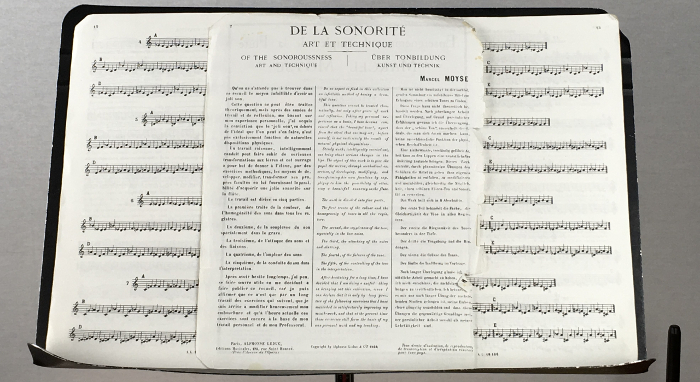How is your tone? Do you feel like it is always improving or are you stuck in a rut? Are you unsure of where to go next for tonal improvement?
Tone, it is an unsung hero in our flute lives. At some point in our career, usually our college and grad school days, we work on tone to the nth degree to improve it to a certain standard. Once it is going in the right direction we then work more on our technical challenges in the ever-increasing difficulty of solos and our tone is just along for the ride.
Everyone wants amazing technique but as Leone Buyse once put it “develop a tone that makes people stand up and take notice.”
 One of the reasons we get stuck in our rut is because we get the idea that our tone is “set.” Yes, we may continue to do our tonal routine with long tones and what not. But are we always looking at ways to improve our tone?
One of the reasons we get stuck in our rut is because we get the idea that our tone is “set.” Yes, we may continue to do our tonal routine with long tones and what not. But are we always looking at ways to improve our tone?
It doesn’t matter how long you have played you can always make improvements in your tonal quality.
Lets take a look at a few exercises to give your tone a boost.
1. Teeth spacing. Use a mirror to look at your embouchure when you are playing. Analyze what it looks like. Now determine how far apart are your teeth? Do you think that an odd question? It isn’t really. Teeth spacing is very important to tone. When a singer worth their salt is performing do you see their teeth closed or do they open wide to let the sound out? Even when a vocalist is performing softly they may close their lips but I assure you that inside it’s a cavern. We flutists can take that technique and make it our own. I’ve written a blog about teeth spacing with specific techniques to help you figure this out. Experiment with this you’ll be glad you did.
2. The lip plate. This is an often-ignored impediment to tonal improvement. When I went to college I had the erroneous idea that where I put my lip plate on my lip was a given and immovable. All other improvements to my tone had to come from some other place. It wasn’t until I went to grad school where I really understood that I could in fact change. I could in fact move my lip plate up or down on my lip to determine the best place for tone production and intonation. The lip plate will have a slightly different positioning based on size and thickness of the lips and shape of the mouth. So, go ahead and experiment. Find a place that feels different and see if your tone is enhanced by this simple change.
3. The tight embouchure is one of the most common issues I come across in my students. I too had a tight embouchure at one time in my life. Students gravitate toward this embouchure when in grade school because it becomes a way to control the air and achieve a better tone. It is true that the tone is less airy because the tight lips leave little room for tone to come out. But it also leaves little room for dynamics and tone colors in the tone. My teacher at the time, the incomparable Georgetta Maiolo, taught me so much about my embouchure and the benefits of a completely relaxed lip shape for the best tone. At first you think that you can’t hold the tone but then you realize your tone is bigger and the world of dynamic and color contrast has just been opened to you. However, you do need to breath properly controlling and supporting your air to achieve the tone you like. See my blog & video for more about relaxed embouchure.
 4. Sinuses play a role in achieving a spectacular resonant sound. It was when I was teaching voice students that this began to ring true to me in the flute world. I never had a teacher talk to me about his but I believe it is crucial to get the tone you are looking for. If you are a singer try this with your voice and then move to the flute. To get my voice students to have a more resonant voice I discuss with them what is happening in the throat and the back of the tongue. Generally, these two areas are not open all the way up through the sinuses. Play your long tones and see if the back of your throat is open all the way down like when you yawn. But also check whether the back of your tongue is down, and your throat open to let the sound resonate through your sinuses. This can make an amazing difference in your tone as you play through your long tones.
4. Sinuses play a role in achieving a spectacular resonant sound. It was when I was teaching voice students that this began to ring true to me in the flute world. I never had a teacher talk to me about his but I believe it is crucial to get the tone you are looking for. If you are a singer try this with your voice and then move to the flute. To get my voice students to have a more resonant voice I discuss with them what is happening in the throat and the back of the tongue. Generally, these two areas are not open all the way up through the sinuses. Play your long tones and see if the back of your throat is open all the way down like when you yawn. But also check whether the back of your tongue is down, and your throat open to let the sound resonate through your sinuses. This can make an amazing difference in your tone as you play through your long tones.
5. Air makes a difference in your tone. Or should I word it that how little air you use makes a difference in your tone. By the time you are in high school or beyond you should have learned to not pass out while playing the flute. Which means that (even if you’re not conscious of this) you’re in fact holding more air in than when you first began. But, unless you are consciously holding air in, you are not reaping the benefits that come from using less air. If the saying “eating fat makes you fat” is true, then the saying “too much air in your tone gives you an airy tone.” It seems like a given, but sometimes the most obvious idea is the one that you need to look at. It almost always comes down to support. When you support your tone, you are in essence holding air in. If you hold your air in and control how it exits across your tone hole, you will improve your tone. This is one of those techniques that you can reap the benefits of immediately. When too much air is exiting through your embouchure it interferes with the tone. Hold that air in, and Viola! the tone miraculously improves. If you need more help in explaining support read my blog on breathing and support. Support, its good for what ails you (or your tone).
Happy Fluting!
Doctor Flute
